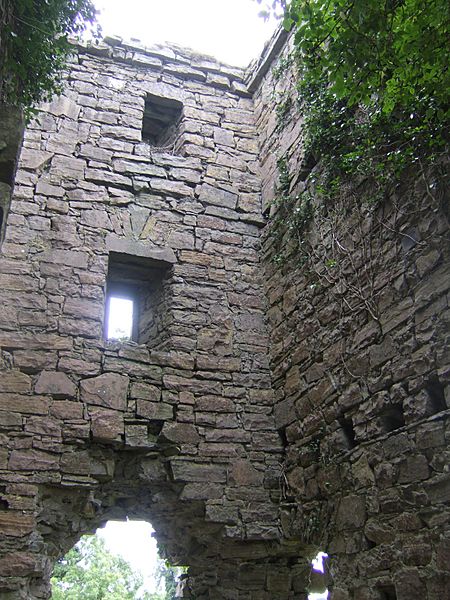Image: Coolamber Hall House - Tower Interior

Description: Coolamber Hall-House is Anglo-Norman in date and can be assigned to the early 13th century[1]. Possibly the residence of Thomas Nugent, 4th Earl of Westmeath, one of the commissioners for Plantation of Longford in 1620 (Cal. pat. rolls Ire., Jas I, 469). Described by Samuel Lewis as ‘the ruins of an old castle, which was beseiged by Oliver Cromwell, it formed the boundary of the English Pale’[2]. Hall-houses consist of two-storey buildings with the entrance doorway on the first floor. The entrance was accessed via an external staircase of wood or stone. The main feature of the building was the large first floor hall which was open up to the roof. The ground floor was accessed via a trapdoor or internal staircase and was probably used as a storage area. Many hall-houses like that at Coolamber have been rebuilt or altered considerably[1]. Summary Coolamber Hall-house consists of a two-storey structure with hour-storey adjoining service tower added-on. It is located on a circular platform c. 4m high and 40m in diameter. A late-medieval church is situated c 400m to the north-west. The platform is enclosed by the remains of a 1.60m thick and .35m high bawn wall that was built in straight sections. There is a small, rectangular, projecting mural tower on the south-west side with an original 3m wide ramped entrance through the south-east side. The condition of the site makes it difficult to determine whether the bawn and mural tower are contemporary with the hall-house and service tower. The hall-house has the remains of a barrel-vault at its northern end at ground floor level. The south end is grass-covered and possibly covers two other barrel-vaults. A doorway in the north-east corner gives access to the tower. A relieving arch, located directly above the barrel-vault of te hall suggests that the service tower may be a later addition to the hall.[1] This fortified house (overall ext. dims. 23.3m N–S; 10.75m E–W) consisted of a two-storey block with an adjoining four-storey tower at its N end. Only fragmentary remains of the walls (max. H 2m) of the two-storey block (approx. int. dims. 16m N–S; 7.5m E–W; wall T 1.6m) survive. Springers in the external face of the S wall of the tower indicate that there was a barrel vault over its ground floor, probably covering the area over the entrance chamber. There would have been another room to the S of this. No trace of the original doorway survives but it may have been in the E wall where there is a large breach opposite the causewayed entrance into the bawn. No architectural features survive. A scar line noted on the external face of the S wall of the tower in 1975 (SMR file) indicates that the roof over this block was gabled. The N and E walls of the tower (ext. dims. 10.6m E–W; 5.6m N–S) survive to wall-walk level, while the W end of the S wall and the W wall have collapsed. The internal face of the N wall is partially covered in ivy at second- and third-floor levels. A base-batter is evident and alternating quoins stones are punch dressed. There is a barrel vault over the ground floor (int. dims. 8.5m E–W; 3.4m N–S; wall T 1m); joist-holes above this in the N and S walls indicate that all the other floors were wooden. A blocked-up doorway, located off-centre to the W in the S wall, gave access to the ground floor of the adjoining block of the house. Another blocked-up doorway near the S end of the W wall led to a mural stairs in the W wall, which accessed the spiral stairs in the NW angle. Apart from a curve in the wall face, indicating its location, no trace of the spiral stairs survives. It was lit by narrow, flat and ogee-headed windows. A chamber (int. dims. 7m E–W; 3m N–S; wall T 1m) on the first floor was lit by an ogee-headed slit ope in the NE angle, flanked by a gun loop to the W, and by a centrally located window in the E wall as well as one off–centre to the W in the N wall. A broken-out fireplace in the centre of the N wall is a fine cut-stone example, with chamfered, punch-dressed jambs and lamp brackets on either side of the destroyed joggle-jointed lintel. A destroyed doorway in the SE angle accessed the first floor of the adjoining block. Remains of broken-out centrally located windows are also visible on the ground, second and third floors of the E wall. Those on the second and third floors consist of flat-headed, single lights. Single lights in the centre of the N wall at second-floor level and off-centre to the E on the third floor are now partially ivy covered. Immediately to the E of the example on the second floor an external chimneystack was carried on two corbels that are visible on the external wall face. The punch-dressed quoins, fireplaces, ogee-headed angle loops, gun loop and flat-headed limestone windows suggest that this house dates to the late 16th/ early 17th-century. A church (LF016-015001-) and graveyard (LF016-015002-) lie c. 475m to the NW.[3] Directions From Edgeworthstown take the N55 towards Granard. After 400m take a right turn onto the R395 towards Castlepollard. The takes a sharp right after 7km and 3km further on Lismacaffry Village is reached. Take the right turn at the crossroads in the village and after 1km take the first right. Pass a small cemetery before reaching the hall-house. Park sensibly. On Private Property.[1]
Title: Coolamber Hall House - Tower Interior
Credit: Own work
Author: Charles T. G. Clarke
Usage Terms: Creative Commons Attribution-Share Alike 4.0
License: CC BY-SA 4.0
License Link: https://creativecommons.org/licenses/by-sa/4.0
Attribution Required?: Yes
Image usage
The following 2 pages link to this image:

